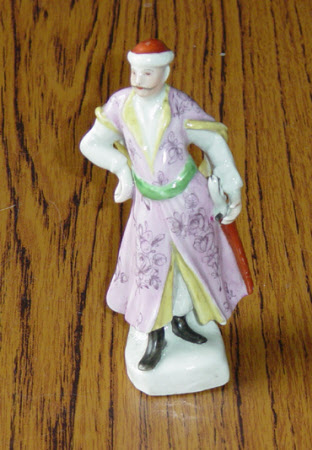Figure
Kloster-Veilsdorf porcelain factory
Category
Ceramics
Date
1760 - 1770
Materials
Ceramic
Measurements
132 x 58 x 50 mm
Place of origin
Germany
Order this imageCollection
Wimpole, Cambridgeshire
NT 205114
Summary
Figure of a Turkish man, hard-paste porcelain, made by the Kloster Veilsdorf porcelain factory, Germany, ca 1760-70; painted with enamel colours and gilded, purple tunic with floral design tied with sash, brown and white turban, sword to left.
Full description
In the 18th century, European porcelain figures were made to present and decorate the dessert course of a meal. They replaced earlier types of wax and sugar figures which often expressed political connections and power. The dessert was the most expensive course in the 18th century. Extravagant, edible creations amidst a fine porcelain table setting demonstrated the wealth and fashionable ‘good’ taste of the hosts. Designed to be seen in the round, these porcelain figures were often displayed in thematic groups, down the centre of a table with candelabra, on mirrored glass to enhance the spectacle. Porcelain was, until the 1700s, almost exclusively produced in East Asia and extremely desirable, fetching very high prices in Europe. It was the Meissen factory in Germany who first managed to make a type of hard-paste porcelain, from about 1710. Soon other European factories, like Kloster Veilsdorf, followed their lead, in response to consumer demand. A factory at Kloster Veilsdorf, near Hildburghausen, Thuringia, was founded in 1759. Commerical manufacture was achieved around 1763 and technical production continues in the same location today.Turkish themes, known as ‘turqueries’, were popular. Meissen was the first factory to make figures of this type, in the 1740s, sold in pairs or sets – male and female. The models were often based on prints, after paintings by French artists such as Nicolas Lancret (1690 –1743) or Jean-Antoine Watteau (baptised 1684 – d. 1721). Terminology note:These types of porcelain figures have historically, in sales and collection inventories, been referred to as ‘Blackamoor’ figures. The term ‘moor’ derives from the Greek work ‘mauros’ meaning ‘black’ or ‘very dark’ and, in the medieval and early modern periods, was an ill-defined stereotype applied to Muslims of the Islamic Iberian Peninsula and North Africa. Usage developed to conflate Muslims of any ethnicity with black Sub-Saharan Africans. People of colour were considered to reflect a luxury within European households, where many were enslaved or employed, although often unpaid, as domestic staff.
Provenance
Part of the Bambridge Collection. The hall and contents were bequeathed to the National Trust in 1976 by Mrs Elsie Bambridge (1896-1976)
Marks and inscriptions
Underside of base: [partly removed label of Filkins & Company, London]
Makers and roles
Kloster-Veilsdorf porcelain factory , maker
